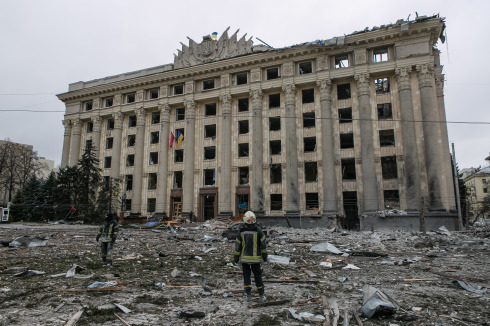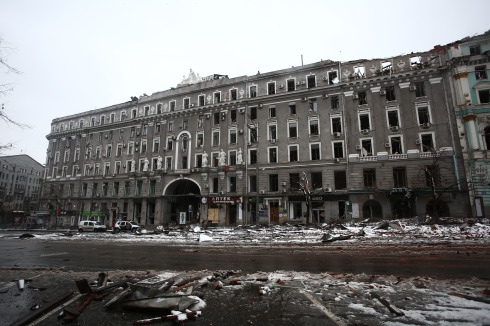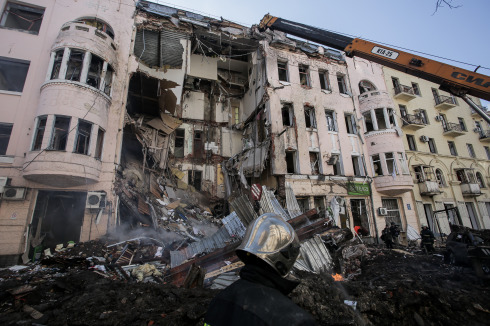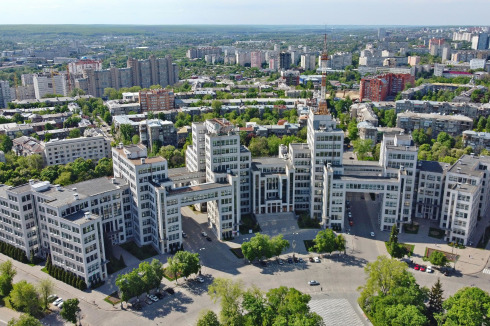All war crimes must be dealt with – including those against our architectural heritage
The Ukrainian architect and architectural historian Ievgeniia Gubkina lived in Kharkiv until the Russian invasion. Now in exile, she spoke to us about the situation in the country's second largest city, the consequences of the war and initial debates about reconstruction.
Text: Crone, Benedikt, Berlin
All war crimes must be dealt with – including those against our architectural heritage
The Ukrainian architect and architectural historian Ievgeniia Gubkina lived in Kharkiv until the Russian invasion. Now in exile, she spoke to us about the situation in the country's second largest city, the consequences of the war and initial debates about reconstruction.
Text: Crone, Benedikt, Berlin
You fled from Kharkiv to Riga with your daughter. How are you doing?
We’re safe here, but of course the situation is difficult. When everything you’ve built up suddenly disappears. It's a terrifying and almost surreal feeling. My husband had to stay in Ukraine and is currently in Lviv. We don't know when the borders will open and we can see each other again.
You worked in Kharkiv as an architectural historian, urbanist and publicist. Are you in contact with colleagues who stayed in the city?
Yes, many of my colleagues and friends, I would call them activists, chose to stay in Kharkiv. Among them are conservators and others committed to protecting the city's cultural and architectural heritage. Kateryna Kublytska, a local conservator and restorer, is trying to secure public cultural objects and monuments in warehouses. A friend of my mother covered the Taras Shevchenko Monument in sandbags. City officials have stayed, as have personalities like Serhiy Zahadan, who has been nominated for the Nobel Prize for Literature, and my friends from the LGBTQ community. Others could not leave the city because they are old or have restricted mobility.
The Russian attacks and destruction in Kharkiv continue [as of March 29th]. How is this affecting your friends and acquaintances in Kharkiv?
They have stayed, and are helping one other. This alone is an act of civil resistance, an act of dignity. Such a state of siege always welds the community together - and the citizens, whether they want to or not, have become heroes. But it's a shame that we were pushed into this situation by Russia at all, because becoming heroes wasn’t our choice. We wanted to live normal lives, now we have to be heroic. That's why I sometimes feel doubts and shame about my decision to leave the country. I'm not in my city with my people, to whom I feel deeply connected. I keep thinking about going back. Everyone I speak to wants to go back and help rebuild the country.
How are people organizing themselves in their engagement for the city: through informal networks or through an official initiative by the city administration?
Through informal contacts exclusively. The city administration is busy putting out fires, clearing rubble and maintaining the technical infrastructure. All other social and voluntary commitments are self-organized, but no less effective.
What is the level of destruction in Kharkiv at the moment?
The official figures for the city currently amount to over 1400 buildings. Almost 1200 of these are residential buildings, which often include many apartments, plus 15 hospitals, 53 kindergartens and 69 of the city's 190 schools. So the main targets are residential areas, especially in the northern Saltivka District, where around half a million people live. These are prefabricated buildings from the Soviet era. In line with urban development, these are open, green areas, but have a very high population density due to building heights. Another destination is the city centre with its administrative and political buildings, and structures of special importance for the identity of Kharkiv. According to the Geneva Conventions, both are inhumane targets, attacks against the civilian population and against historical heritage. In the city centre, by a roughly estimate, half of the buildings of architectural significance have been damaged or destroyed.
A structural landmark of modernism in Kharkiv is the Constructivist building complex Derschprom, realized in 1935, and designed by Sergei Serafimow, Mark Felger and Samuil Krawez. Is it still standing?
Yes, the complex is still intact. Only houses in the immediate vicinity were hit - which incidentally was also the case in the Second World War. I hope this luck lasts. However, parts of the Palace of Labor were destroyed, a large, block-like building that was constructed in a late Neo-classical style of in 1914, and was taken over by trade unions in 1917 after the October Revolution. The State Regional Administration Building – designed by a Jewish-Ukrainian architect Yakov Steinberg in 1931 in accordance with the theory of historical materialism, but substantially redesigned after the Second World War in the style of Socialist Realism – was also hit in an attack. A house on Svobody Street by the architect Mosey Meletinsky still features Art Nouveau-style interiors, a rare heritage in the city. These rooms in particular have now been largely destroyed. A Constructivist residential building on the Sumskaya Street, which was well-preserved and renovated last year, has also had a large hole since an attack. Among the red brick buildings for which Kharkiv is known, and which are part of the local cultural heritage, there is a beautiful fire station with a watchtower and adjacent residential complex to the west of the city center. Unfortunately, the complex was hit so badly yesterday that I'm not sure if it will be possible to rebuild.
So it's not also, but primarily, civilian buildings that are hit?
Yes, not factories or military targets. Grotesquely enough, the Russian attacks also hit memorials. In Kharkov, this includes a site in Pjatychatky where several thousand Polish officers who were evacuated by the Soviet NKVD in 1940 were murdered. The memorial for the soldiers of the Red Army and the Menorah monument, which commemorates the Jewish victims in Drobytskyi Yar, a mass shooting under German occupation, were also damaged. I only ask: Why? What is the purpose behind it?
One explanation is that Putin is planning to “demoralize” the population. Historically, however, such brutal action has seldom been crowned with success.
In Kharkiv, too, the destruction is achieving the very opposite of what it intends. Before the war, some people in the city supported Russian policies, but that’s no longer the case. Instead, anger and hatred are growing, and the prospect of being able to forgive one day is dwindling. The experience of such aggression is passed on from generation to generation. It is unforgivable. In the first few days we still tried to discuss things and to understand the Russian perspective. But the moment for dialogue has passed. Instead, a desire for revenge is growing. Given the situation, it will be difficult for us to rediscover a tolerant and democratic attitude. After the war, I would expect – as a minimum – a judicial investigation of the war crimes. The destruction of civilian buildings and of the architectural heritage must also be a part of these court proceedings. We are already in contact with US lawyers on this question. I also support the return of cultural assets and works of art from Russian museums and archives that were stolen from Ukraine previously.
When bombs were still falling in World War II, planners were already busy completely redesigning the layout of the destroyed cities. Are Ukrainian architects already talking about reconstruction?
Talks about various approaches to reconstruction began on the first day of the war. Even now, conversations and discussions often end with the question of how to reconstruct the cities. It is probably in the nature of the architect's profession to deal with building - or reconstructing - under all circumstances. And yes, especially among younger planners, there is an urge to plan cities in a new and different way than before. The city governments and private investors are in accord with this desire. Last but not least, President Volodymyr Zelensky has emphasized in many speeches that the cities should be rebuilt with the involvement of national, European and American architectural offices – and even better than before. It seems as though history repeats itself. On the other hand, there are conservators and preservationists who are committed to preserving and reconstructing the previous state of things as faithfully as possible.
What would you advise?
We should base our decisions on legal requirements. These stipulate that at least buildings that are found on local or national lists of cultural assets, or have a UNESCO title, should be reconstructed. Apart from that, I would ask the international community for support in reforming our legal situation regarding the way we deal with buildings of architectural importance. Because our current legal basis for this is a legacy of the Soviet era, where – unfortunately – the possibility of completely changing buildings was deliberately left open. It’s also important that larger complexes or urban areas of a specific era are considered as a whole and placed under urban planning protection. This protective status was a thorn in the side of the developers even before the war. On this basis, the architects can in turn make their contributions to a new Kharkiv. The residential area of Saltivka, which never made it onto any cultural heritage list, could become an exemplary place where old meets new.
Do you also see a chance for a new, participatory approach here instead of a top-down reconstruction, as it was the case after the Second World War?
Absolutely. We are further developed in European urban planning than we were decades ago, and everyone, especially people who have been affected by the war and have been traumatized, should be involved in reconstruction. This form of participation is not just a procedure for big city hipsters, but for society as a whole, as a means of overcoming war. But I also see an opportunity for a new approach to our cultural assets. The world will watch to see whether and how the built heritage is preserved in Ukraine. In this context, UNESCO's approach of including numerous buildings on temporary candidate lists, and thus de facto failing to protect them, is intolerable. We're tired of nominating things! We need some certainty about our architectural heritage. But politically as well, the uncertainty for our country within Europe must come to an end.
How can the architectural world outside of Ukraine contribute?
There are voices in the Ukrainian architectural community who believe that projects should only be designed and executed by offices in their own country. But I think international competitions are a good way to dedicate yourself to reconstruction as openly and transparently as possible. The open and global brainstorming of ideas among planners can be very helpful, as long as it’s respectful of the needs of the population and the history of the city.
At the start of our conversation, you said that you had to leave your life behind. But you are still in contact with your people in Kharkiv. Can you, in some way, continue to work on your projects?
My main activity is writing for publication, which is only possible to a limited extent in exile. In December, I submitted a manuscript of an Architectural Guide to Kharkiv to DOM publishers. It was staggering to watch the buildings on my list being hit and destroyed, one after the next. I will now make changes to the text and address the war damage. But the release is still planned.
----
Ievgeniia Gubkina
Architect, historian of architecture, curator of architecture and art projects, educational activities. She is a co-founder of the NGO Urban Forms Center and the avant-garde women's movement “Modernistki”. Her work specializes in architecture and urban planning of the 20th in Ukraine, and multidispinary approach to heritage studies. Her first book “Slavutych: Architectural Guide” was published in 2015 by DOM Publishers in Germany and was dedicated to the architecture of the last Soviet city of Slavutych, built after the Chornobyl disaster for workers of the Chornobyl nuclear power plant. In 2019, after many years of research, her second book “Soviet Modernism. Brutalism. Post-Modernism. Buildings and Structures in Ukraine 1955–1991” was published by Osnovy Publishing and DOM Publishers. In 2020 she curated the “Encyclopedia of Ukrainian Architecture” multimedia online project. After the Russian war against Ukraine started in 2022, she was forced to leave Kharkiv and temporarily moved to Latvia.













0 Kommentare